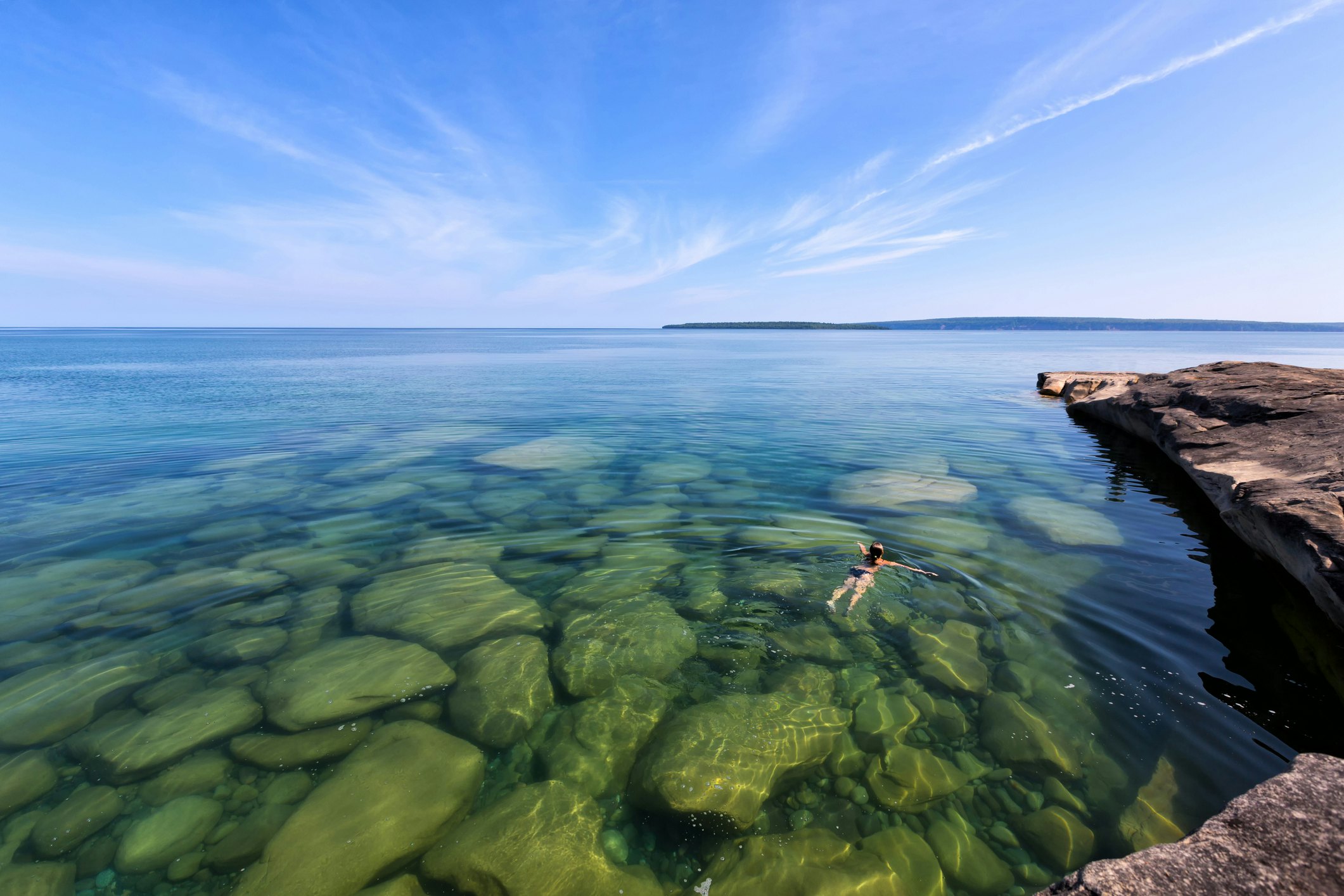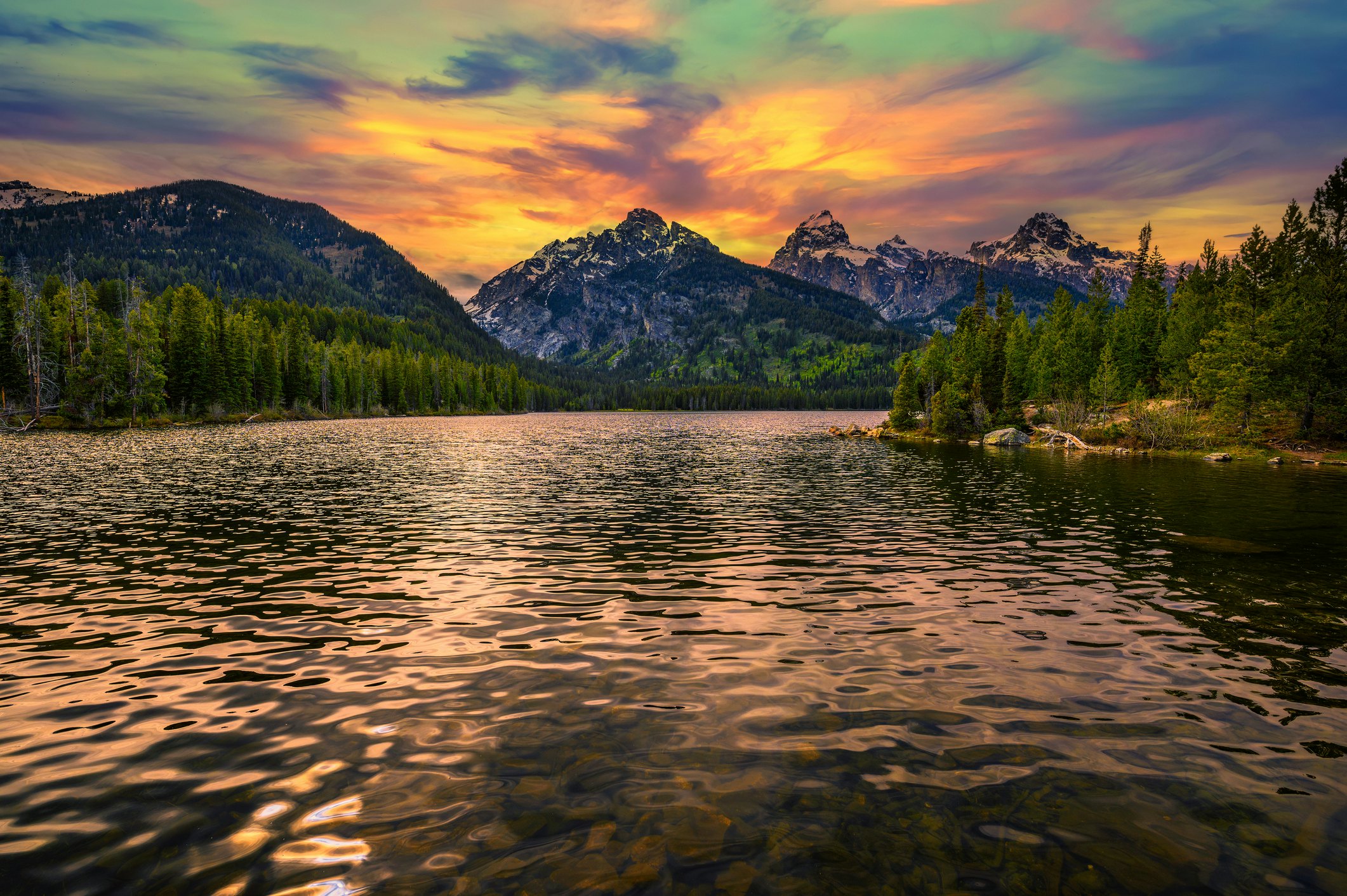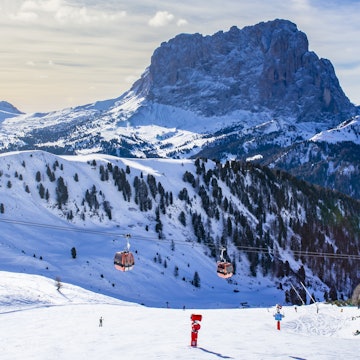

Cold plunging benefits include a dopamine rush, improved energy levels and laughter © SolStock / Getty Images
Whether you are a die-hard ice bath fan with a cold plunge tub in your backyard or looking to try cold plunging for the first time, several destinations marry invigorating chills with arresting vistas.
Avid followers of the Wim Hof Method can espouse the benefits of cold water therapy – mindfulness, mental strength, alertness, exhilaration, stress relief – but taking a cold plunge doesn't have to be a challenge.
Conscious breathing can aid focus as you gaze across arresting views of nature whilst taking an ice bath and some of the world's best bodies of water will activate those feel-good chemicals in your brain. After a while, it becomes hard to tell if the high you get is from the cold water or the magic of the surrounding landscapes. Selected from our book, The Joy of Wild Swimming, here are the best places in the world to take a cold plunge.

1. Lake Joutolampi, Lapland, Finland
Framed by a thicket of ancient pine, Lapland's Lake Joutolampi is so chilly that swimmers need to wear a special waterproof 'float suit' to take cold water plunge. But what a place to do it: floating in the lake's frigid waters as the midnight sun lights up the swirling snow of the Arctic Circle.
The lapping of the water and the scent of pines can almost lull you asleep like a spa treatment. After your cold plunge, do as the Finns do and warm up by a fire and drink blueberry juice from a kuksa (Finnish wooden cup).
Getting there: Located around 15 miles (22km) north of Joutolampi, near Lake Norvajärvi, don't confuse Lake Joutolampi for its namesake further north near Sodankylä. The lake makes a great detour on the way from Rovaniemi to Inari, another popular Lapland destination.
Challenge level: endure or invigorate? The 'float suits' make this an invigorating cold water plunge. You will need good mobility to reach the lake which is accessible via a forest trail and then a wooden platform.

2. Akchour Waterfalls, Talassemtane National Park, Morocco
Plunging some 260ft (80m), the Grandes Cascades d’Akchour (the upper cascades of the Akchour Waterfalls) are one cold-water dip worth the hike. Both the views and water temperatures at 1000ft (325m) are breathtaking with greenery and moss covering the travertine mountainside. The surrounding cedar, holm oak, cork oak, juniper and carob help create a natural perfume for swimmers too.
The trail starts six miles (11km) from the small village of Akchour in Talassemtane National Park and the scenery along the route is almost as good as the falls themselves. You follow the pretty river up the mountain valley, past cafés offering drinks and tagines, and through an area of smaller waterfalls that are very popular with locals. An hour from the top, you will reach the lower cascades; keep going through the gorge and you’ll reach the upper falls.
Getting there: From Chefchaouen, take a grand taxi (Dh30 per seat, or Dh180 for the whole vehicle) to Akchour in Talassemtane National Park. At the end of the village, cross over the bridge and head up the path to the left of the dam. The walk to the upper waterfall takes around 2½ to 3 hours each way.
Challenge level: endure or invigorate? Swimming at the Akchour Waterfalls is easy enough with smooth rocks on the bottom of the pools, but the water is always freezing. The walk to the pool is moderate and involves some scrambling over rocks.

3. Lake Superior, Minnesota, USA
Not one for cold plunge newbies, the water at Lake Superior is so cold that even the bacteria that makes dead bodies float cannot grow here. The annual average surface temperature of the lake is just 4°C (40°F), ideal for a cold plunge – particularly one that starts with a primal scream. Don't go cold plunging on your own.
Roughly the size of Austria, the world's largest freshwater lake has scores of beaches to choose from: ribbons of yellow sand; smooth pancake-sized pebbles made of basalt, rhyolite and prize agates; granite ledges that slope into the water.
The best place to take the plunge is at the end of Park Point, a 7-mile-long beach (11km) that juts out from hilly Duluth, Minnesota. It's so shallow here that you can walk out 50m (160ft) and still be only waist deep. This slow immersion gives your body time to numb itself to the cold. When you reach chest high, sink in and swim. You may only last a few minutes, but it’s enough to feel vibrant, energized and alive for the rest of the day. Visit in July to September and water temperatures reach a relatively balmy 15°C (60°F).
Getting there: Daily buses run hourly from the downtown transportation center in Duluth to the end of Park Point (from Memorial Day to Labor Day). From the bus, it’s a 10-minute walk over the dunes to the beach at Lake Superior.
Challenge level: endure or invigorate? Considering the very low water temperatures this is one to endure. This is a cold plunge is for experienced swimmers only. Beware of the occasional rip tide. Swim parallel to the shore and avoid going in if there are big waves.

4. Taggart Lake, Wyoming, USA
Wyoming’s Grand Teton National Park is among the most striking in North America. It sits on the ancestral land of the Shoshone Nation, who named the region Teewinot, meaning ‘many pinnacles’ – and you can see why. Scattered among the ravines are several jewel-like alpine lakes formed by snow and ice melt.
A cold plunge in any of them will invigorate the senses but Taggert Lake is the most picturesque. The 3.8-mile (6km) loop that abuts the lake's shoreline is one of the best wildflower walks in the park, dotted with sky blue-colored alpine forget-me-nots, bright purple sky pilots, and golden yellow parsnip flowers. When you emerge from the forest path at the northwestern corner of the trail loop, Taggart Lake reveals itself. In the water, you will see fallen trees perfectly preserved by the lake’s cold temperature. Take a deep breath and then take the plunge of a lifetime. This is glacial swimming at its finest.
Getting there: The Taggart Lake trailhead is easily accessible from the main road that runs the length of the park. The trailhead is approximately a 20-minute drive from the Grand Teton Park sign. There is limited parking.
Challenge level: endure or invigorate? The cold plunge is one to endure due to the near-freezing temperatures. Come prepared with dry clothes, a quick-dry towel, plus anything else you might need to get warm. The hike to the lake is short and largely flat, though not paved. It's good for families and those with mobility issues but wheelchair users may face some difficulties.

5. Cold Lake, Alberta, Canada
Only once you dive into Alberta’s Cold Lake will you truly understand how appropriate its name is. The frigid water temperature can cure for overthinking (and a hangover). Clear enough to see right to the bottom, dig into the sand and you’ll see the fine pink-and-purple grains of garnet stones. If you can stay until dark, you may be lucky enough to see the northern lights flicker over Cold Lake – maybe even take a moonlit plunge under the stars.
Getting there: Cold Lake is roughly a 3½-hour drive northeast of Edmonton, Alberta, on the Saskatchewan border. There is no bus service here, so you’ll need a car.
Challenge level: endure or invigorate? The water’s cold temperatures might set your heart racing, but little else about this adventure will. It's an invigorating swim. Kinosoo Beach and Cold Lake Provincial Park offer two of the most accessible beaches, with sandy lakebeds and hardly any rocks.

6. Katsura River, Kyoto, Japan
In the hills northwest of Kyoto, the Katsura River runs beneath the maple trees. Its blue-green water opens up to shallow beaches and swimming holes that welcome visitors to take a dip. With frigid waters that sweep downstream from the mountains, this is a more temperate environment for a cold plunge whilst still being a very refreshing swim. Your senses will heighten as you slide into the water. Take deep breaths and enjoy the scent of the cedar trees that line the shore.
Immersing oneself in natural water has been a favorite pastime of the Japanese for hundreds of years. Every day, from dawn until dark, people gather in this natural retreat. As long as the river is still flowing, the bravest are here year-round, even when Kyoto temperatures plunge below freezing.
Getting there: The fastest way to Utsukyo is to drive from Kyoto. The journey takes an hour. Alternatively, you can take a Sanin Line train from Kyoto to Sonobe and then a taxi to Utsukyo Park Camping Ground.
Challenge level: endure or invigorate? The swimming spot at Utsukyo Park Camping Ground is suitable for all ages and abilities. Currents are gentle and the water is shallow enough to stand. Some more remote swimming holes along the river require a short hike or a higher level of physical exertion to enter but this is an invigorating swim. During winter, however, the waters become very cold. Do not swim alone.

7. Lago di Braies, South Tyrol, Italy
Only the bravest cold plungers dare to dip in mountain lakes and Lago di Braies rewards the hardiest of souls. Set at an elevation of almost 1500m (4900ft), all dips here will be short, sharp and scintillating. Luckily, while you face an exhilarating dip, you can enjoy a spectacular view of the limestone peaks of the Dolomites. A welcome distraction as you push off into the frigid waters of the lake.
As you swim, turn your attention to the southern shore of the lake, and the hulking 2810m (9219ft) Croda del Becco mountain. In Ladin mythology, this peak is supposedly an entrance to an underworld, and every 100 years a secret door opens, and a beautiful princess will row across the lake under a full moon. We don't know if it's true but anyone heroic enough to submerge themselves in the waters of Lago di Braies might justifiably emerge feeling somewhat legendary themselves.
Getting there: Getting to Lago di Braies on public transport is convoluted but doable. Take the train from Bolzano to Franzensfeste and then bus 442 to Braies (known as Pragser Wildsee in German). Journies take around 2½ hours.
Challenge level: endure or invigorate? Endure. Temperatures in Lago di Braies will rarely creep above 4°C (39°F) – in the depths of winter, the water may freeze. Whenever you visit, have lots of warm, dry clothes and a flask of something hot for when you emerge. Outside of summer, swim close to the northern shore, so you can withdraw to the warmth of the hotel (or a parked car).

8. The Forty Foot, Dublin, Ireland
The Forty Foot in Dublin is “bloody cold” swimming at its finest. This is the spot where locals will swim year-round, no matter what the weather. For the first 200 years of its existence, the Forty Foot was a male-only bathing spot, but in 1974 women were welcomed into the cement pad of a lounging space that leads out to the chilly waters. If the Forty Foot looks and sounds familiar, it’s likely you’ve heard (and seen) it on the Apple TV series Bad Sisters, when all of the Garvey sisters take a Christmas cold plunge into Dublin Bay.
Much like in the series, you’ll find people of all ages sitting on the edges of the rock or cement patio talking, laughing, and warming up with a flask of something toasty. It’s free to enter and to swim – and it’s as much a social experience as it is a test of your mettle. So if you’re prepared for both it’ll be a true (but cold) delight.
Getting there: Take the Dart (Dublin Area Rapid Transit) rail link from various central Dublin stops to Sandycove and Glasthule station, then walk east for 15 minutes along the waterfront.
Challenge level: endure or invigorate? Invigorate. The water at the Forty Foot reaches a maximum of about 16°C (60°F) in August so most swimmers just hop in for a brisk dip. You can swim at high or low tides, but submerged rocks make jumping risky unless you know where to go – either follow the locals or use the steps at the end of the path where there is a handrail. The swell here can be quite strong, so take care when exiting the water.

9. Rambergstranda, Lofoten Islands, Norway
The Lofoten archipelago is a place of extreme natural beauty. Each Island has jagged granite mountains that look as if they’re piercing the sky. The shores are dotted with bright red huts from the days of fishermen dominating these parts (now most serve as guest houses).
Though the fishing trade is still alive here, it’s the ocean that’s the main draw for tourists and locals alike. Deep fjords allow the salty waters to creep inland. Though Rambergstranda on the island of Flakstadøya is unmistakably a beach, its pristine white sands and calm turquoise sea feel more appropriate for the Caribbean than the Arctic Ocean.
Only once you step into the water is the illusion broken, the temperature far from tropical. This is cold therapy in the style of ‘Iceman’ Wim Hof, so steady your breathing as you suck in that Arctic air. After the cold plunge, it’s important to warm up, and nothing is better than a glass of local firewater, aquavit.
Getting there: Lofoten’s main airports are at Svolvær and Leknes, and the latter is closer to Rambergstranda. A relatively infrequent bus service from Leknes, a 20-minute walk from the airport, to the village of Å will get you to the beach in about half an hour. For more freedom, rent a car.
Challenge level: endure or invigorate? Due to tides, there may be a substantial walk across the sand to the water, making this swim unsuitable for those with mobility issues. Be sure to check local advice on swimming conditions, and err on the side of caution if you’re unaccustomed to cold water. This is one to endure, so stay in no longer than ten minutes.

10. Lake Wakatipu, Queenstown, New Zealand
Ice-cold rivers flow into this South Island mountain lake, which makes for cold water, even in summer (11.5°C/53°F is average). While some might want to don a wetsuit, for the bravest cold swimmers this is a fine temperature to take the plunge.
Shaped like a cartoon lightning bolt, Lake Wakatipu is NZ's third-largest lake. Five rivers flow into it but only one (the Kawarau) flows out. Scientists have rated the lake as 99.9% pure, so you may want to leave your bottled water at home in favor of this very fresh, and refreshingly cold, water. But please do still test the water before you drink it.
Getting there: There are several ways to get to Lake Wakatipu, with tours being a popular option. While there is public transportation available from Queenstown via bus, the closest stop is still a 15-minute walk from the lake, so plan your transport accordingly.
Challenge level: endure or invigorate? Safe for recreational swimmers, Wakatipu is a fairly calm lake despite its invigoratingly cold temps. However, due to the cold waters, if you decide to see the lake by boat, local by-laws require the wearing of life jackets in all boats under 6m, including kayaks, on the lake.














